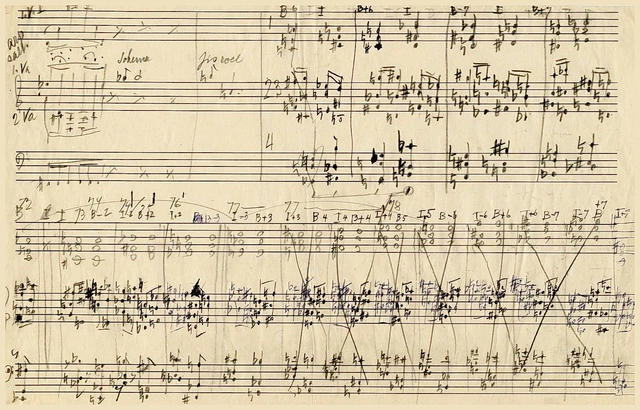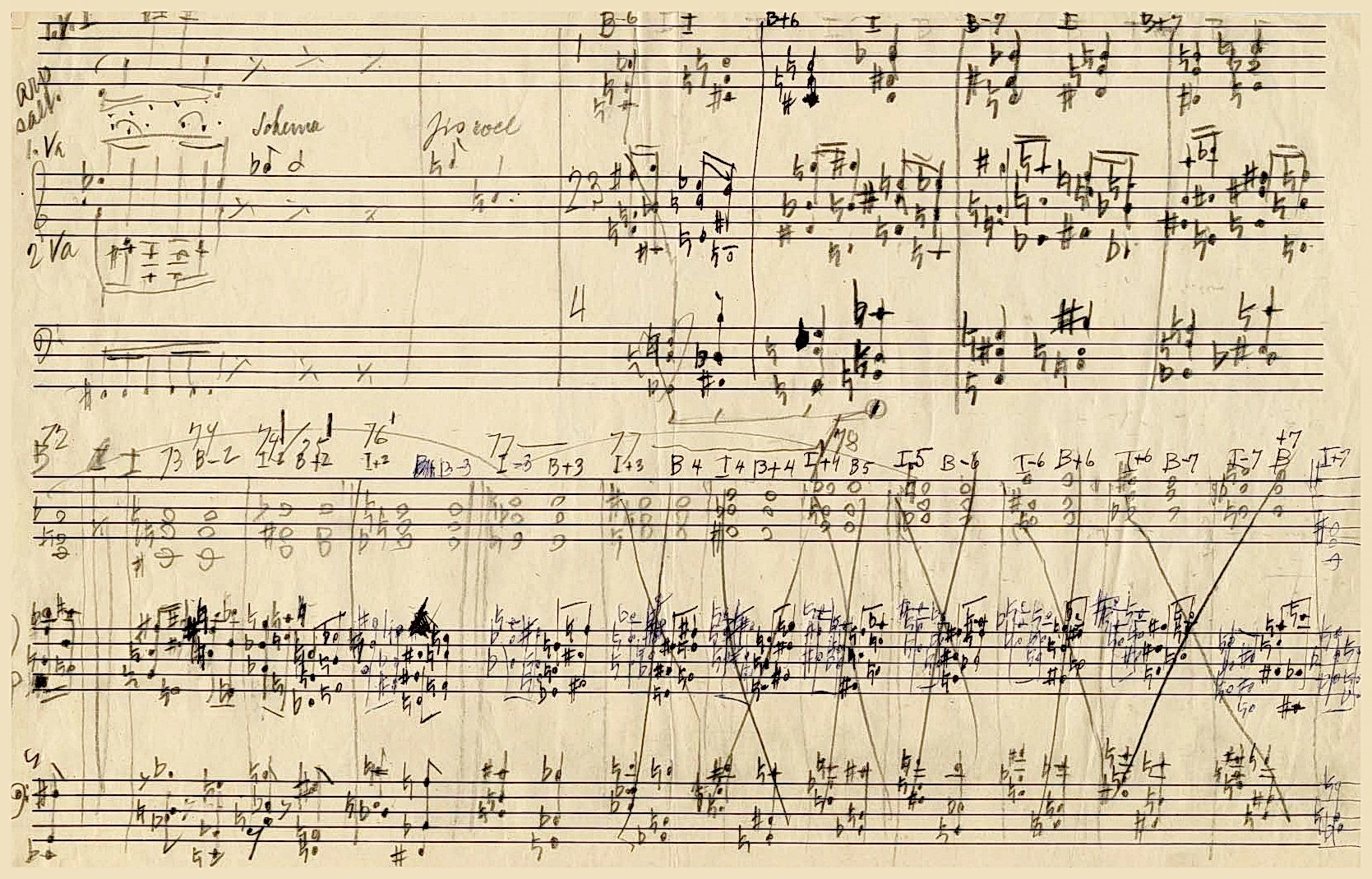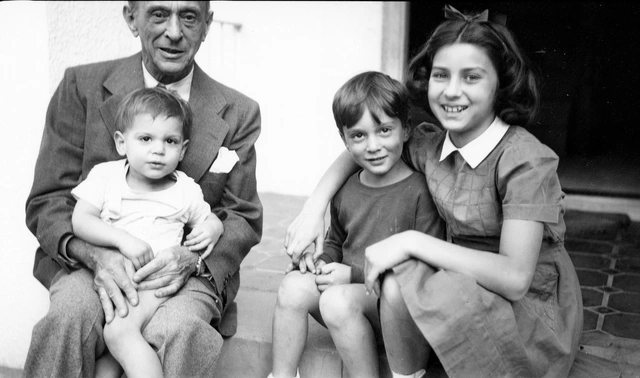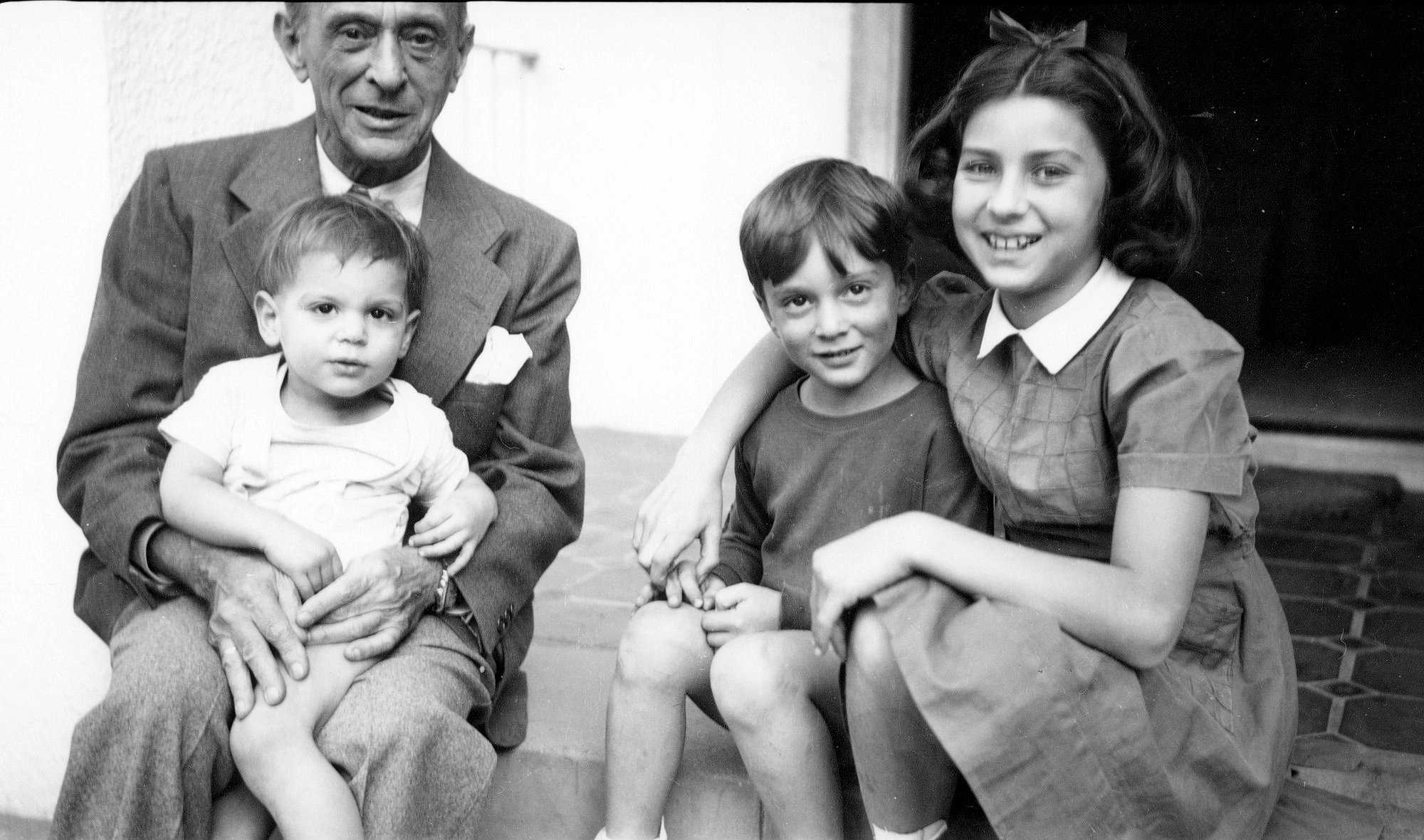Arnold Schönberg – Biography
“Nothing is as fundamentally radical as renewal that simply results from the process of growing. While time and again all revolutions only provoke reaction, and can endanger long-term growth. I was never a revolutionary!”
Arnold Schönberg: Neue Musik (1923)
Arnold Schönberg was born on September 13, 1874 in Vienna to Jewish parents. His musical training was largely autodidactic, supported by student friends including Alexander Zemlinsky who would later become his brother-in-law. In 1899 Schönberg composed his first larger work, the tone poem “Transfigured Night,” op. 4 for string sextet. In 1901 he married Zemlinsky’s sister Mathilde, with whom he had two children: Gertrude (1902–1947) and Georg (1906–1974). The couple moved to Berlin, where Schönberg earned his living from writing orchestrations of operettas, teaching students, and conducting a cabaret orchestra.
In 1903 Schönberg returned to Vienna. The many students taught by him over the decades included Anton Webern and Alban Berg, who would later become close friends as well. While his early works were influenced by the composers Richard Wagner and Johannes Brahms, and also his contemporary Richard Strauss, Schönberg gradually advanced to adopt a tonal language that was detached from any major/minor tonality and that was to shape the works in his expressionist phase. During the premieres of his String Quartet No. 1, op. 7 (1905) and String Quartet No. 2, op. 10 (1908) there was hostility among sections of the audience, and unsympathetic reviews followed. This period was tarnished by Mathilde’s affair with the painter Richard Gerstl, who gave the couple painting lessons and committed suicide after Mathilde returned to her husband. From 1910 Schönberg also exhibited his paintings and drawings, initially in a solo exhibition and later in connection with the Neukunst (New Art) Group around Egon Schiele, and lastly with the artists of Der Blaue Reiter (The Blue Rider).
“I must answer that as a painter I was absolutely an amateur; I had no theoretical training and only little aesthetic training […]. [Painting] was to me a way of expressing myself, of presenting emotions, ideas, and other feelings; and this is perhaps the way to understand these paintings.”
Arnold Schönberg: Museum Talk on Painting (1949)
In 1911, the year in which his “Harmonielehre” was published, Schönberg accepted a position as a lecturer in Berlin, where in 1912 he composed one of his most influential works: “Pierrot lunaire,” op. 21. In 1915 he returned to Vienna. During the years of the First World War, hardly any works were ready for publication. Besides the “Four songs for voice and orchestra,” op. 22, he worked on the oratorio “Jacob’s Ladder” which remained a fragment. In both his compositions and writings on theory, he sought ways of organizing the freely-tonal sound space according to logical criteria. An important role was played by his exploration of contrapuntal compositional techniques, particularly in the music of Johann Sebastian Bach, whose choral “Komm, Gott, Schöpfer, Heiliger Geist” BWV 667 Schönberg arranged for large orchestra in 1922. From 1920 to 1923 Schönberg developed the “Method of composing with twelve tones which are related only with one another,” a system of ordering for compositional purposes which would have a lasting effect on generations to come. Significant compositions that were written while he was working on this method are “Serenade,” op. 24 and the “Wind Quintet,” op. 26 that was dedicated to his grandson Arnold.
“It seems to me urgent to warn my friends against orthodoxy. Composing with twelve tones is not nearly as forbidding and exclusive a method as is popularly believed. It is primarily a method demanding logical order and organization, of which comprehensibility should be the main result.”
Arnold Schönberg: My Evolution (1949)
“Interpretation is necessary to bridge the gap between the author’s idea and the contemporary ear, the assimilative powers of the listener at the time in question. As an interpreter of his own works, the composer sets a standard more through the way his performance alters than, for example, through the tempi he is supposed to have taken.”
Arnold Schönberg: Mechanical Musical Instruments (1926)
In 1923 Schönberg’s first wife Mathilde died; one year later he married Gertrud Kolisch, sister of the violinist Rudolf Kolisch. His professorship at the Prussian Academy of Arts at last gave the composer a prestigious position, financial security and a stable family life. In 1932, the year in which his daughter Nuria was born, he completed the second act of his scenic oratorio “Moses and Aaron.” Both the opera and his major orchestral work “Variations for Orchestra,” op. 31 are based on a single twelve-tone row. Lectures and new works enabled Schönberg to reach broader audiences. In 1928/29 the composer wrote the light comic opera “From today till tomorrow,” op. 32, which he conducted himself in a radio broadcast, and in 1933 an arrangement based on George Frideric Handel followed in which the work of this Baroque composer was imbued with the esthetic ideas of modern music.
In 1933, when the National Socialists seized power in Germany, Schönberg was removed from his position due to his Jewish origins. He spent a brief period in France with his family, after which in October they emigrated to the United States, where Schönberg initially accepted a teaching position in Boston. The following year he moved to Los Angeles for health reasons, where his two youngest sons Ronald (*1937) and Lawrence (*1941) were born. After a year’s lecturing at the University of Southern California (1935) Schönberg taught at the University of California at Los Angeles between 1936 and 1944; in 1941 he was awarded US citizenship. The experience in exile and threat of National Socialism found expression in works like the Piano Concerto, op. 42, Ode to Napoleon Buonaparte, op. 41 and A Survivor from Warsaw, op. 46. In 1946 Schönberg was taken seriously ill and suffered a cardiac arrest. This experience was processed by him in his String Trio, op. 45 which was written shortly after his recovery. After he retired, Schönberg continued with his teaching and composing activities. He died in Los Angeles on July 13, 1951.
(Text: Arnold Schönberg Center)














